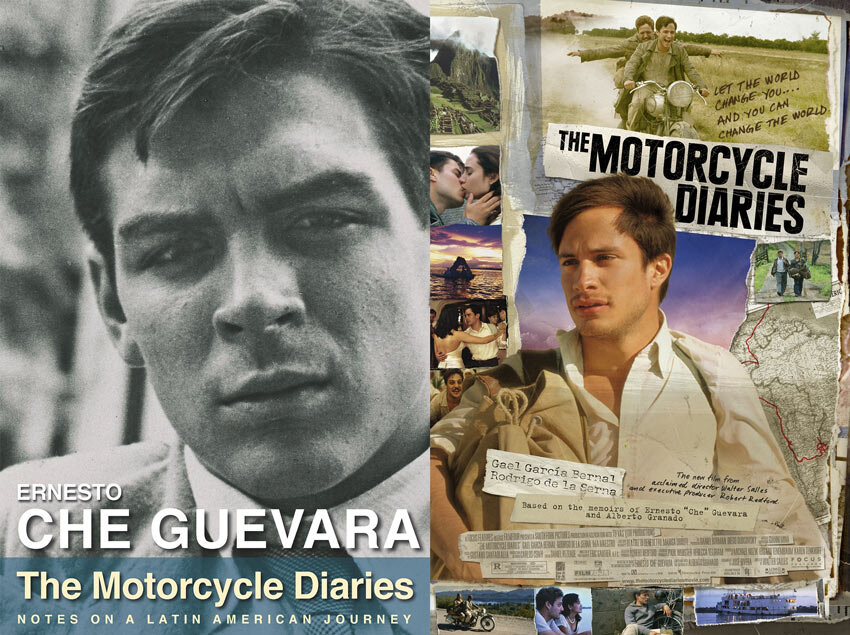
(Image: focusfeatures.com)
Che’s Transformative Journey without a Motorcycle
By Gabriel Hernandez
An 8,000 km journey across South America from Argentina to Peru will change people's perspective on life, an experience that will change the way one sees injustices around the world. The viewer will get a grasp on the discrimination between the upper-class communities and the indigenous people across Latin America in 1952. The story of Ernesto "Che" Guevara and his friend Alberto Granado's journey through South America was not meant to portray Che Guevara as a hero by any means. I believe it was only meant to recall the trip that molded him through the basis of his memoir. He described himself as a transformed man once the journey was completed from what he saw, whom he had met, and his near-death experiences on the road. Before the trip, Che was coming from a middle-class family and a semester away from completing medical school. He was on his way to live a successful life as a doctor.
In this article, I am going to argue that Che Guevara's experiences throughout the journey made him change his way of thinking; he was a different man afterward. He eventually went to fight for human rights across the world. Che's journey across South America was anything but easy. The breaking down of his motorcycle made his trip much more complicated than it should be. Che and Alberto's struggles came to be, but when they were making their journey by foot or hitchhiking, they noticed what life was like in the rural. Going from a rural community to a rural community, Che was starting to realize the social discrimination that the kind indigenous people were facing. They lacked basic needs, like healthcare or any other resources. There is also the idea of spatial discrimination that I believe realized from his encounters with the communities. He noticed how well developed the cities were designed, compared to the outskirts. The essentials needed to live a quality life were not there, sewage, water accessibility, and even the infrastructure. I think him noticing all these lacks resources for the people that helped him the most made him change his way of thinking, and he wanted to give them the voice they never had since the Spanish had colonized the area.
From beginning to end, Che had firsthand experience with spatial discrimination as well as social discrimination through the architecture or lack of architecture he had seen on his trip. Spatial and social discrimination are two human-made types of equality that have seen throughout history. The simple fact that those who develop and build cities make it difficult for individuals, often sick or people of color, people with disabilities, illness, or beliefs access to certain places or meet specific needs for basic survival. Discrimination is everywhere, developed countries, major cities, and even within rural communities. The harmful design of infrastructure is placed without giving those affected the most a voice to speak up, and it affects them the most because it makes life difficult for them. From Che's experience, the indigenous people and those living in the rural seemed to be the ones affected most. Throughout the paper, I will provide insight into certain situations that I believed evoked Che Guevara to bring light to these people with no voice.
When the movie starts, it follows Che and Alberto through the beginning of their journey. It seemed as if the camera was the third person involved in their adventure. They get off to a good start, motorcycle moving through dirt roads, both focused on the way and distracted from their surroundings. Stan Allen stated in Dazed and Confused, "the experience of the road - it is not a place itself but a passage, a vector, space between." Moreover, this was how Che and Alberto were treating it as. The passageway from Argentina to their destination in Peru with no worries. Walter Salles, the director, paints the picture as an ideal road trip showing the men greeting the indigenous farmers, seeing beautiful landscapes, while the motorcycle was running strong.
Che's transformation almost would not have happened if their form of transportation never broke down; they would have reached the leper colony in their desired time. The motorcycle breaking down and their troubles all seemed as if their journey was supposed to have gone, like a movie in real life with an exposition, rising action, climax, and resolution. Che goes through all these troubles to open his eyes and see the world outside of the bourgeoise. The idea of the broken tool takes me to the breakdown of Heidegger's ontology or study of being where he attempts to access through phenomenological analysis of human existence. The idea of the broken object was the idea that if you had a working tool and at a certain point it refuses to work, then at that point, you start to engage or disengage with your surroundings. In the film, it was not until they began having motorcycle troubles for them to start noticing their surrounding environments and seeing past the picturesque landscapes. Once they began facing adversity, whether it was their motorcycle troubles or housing complications was when they started seeing the big picture of life out in the rural. They noticed the vast difference in the quality of life, the treatment of people, and wealth distribution that made them think of their privileged lives back home. What was supposed to be a simple journey turned to a path filled with a variety of distractions, that ultimately gave Che his life focus? The various distractions seemed to have transformed him to fight social injustice not for Argentina, his home country, but for anyone that faced these inequalities.

Spatial discrimination with minimal separation between the city and the rural communities.
From beginning to end, Che always seems to be affected by his surroundings and what he sees throughout the different countries. Che recognized the indigenous living conditions and how the wealthy treated the poor, especially when trying to find employment. There were events throughout his journey when I noticed his behavior change. There is a scene when both arrive in Machu Pichu and takin in its greatness. She is then seen pondering and talking to himself, he mentions the vast knowledge and power that the Incas had, but the Spanish were able to conquer the Mayans because they had the gun powder. He then wonders and asks, "What would America look like today if things had been different?". He is questioning the quality of life for those who reside in South America. While walking around the ruins, he then says, "How is it possible to feel nostalgia for the world I never knew?" meaning he is slowly starting to feel as if he is beginning to feel the connection with the indigenous people. As he walks around the site, he says, "How can a civilization that built this" while the camera showing a panorama of Machu Picchu sitting in the Andes, "...be destroyed to build...this?" With camera changing shots from Machu Picchu to a picture shot of Lima, Peru, an urban sprawled city was covering the landscape of Peru's coast. For the first time in the film, Che questions the authority and feels for the indigenous people what they have gone through. As if everything he has seen throughout the trip has become a part of him. They went from being one of the most advanced civilizations in the world to being completely forgotten. I assume this was the initial start of his transformation. This event put the injustice of the indigenous people into perspective. At one point in history, they were one of the most advanced societies in the world, with their citadel being one of the seven wonders in the world, to now being completely forgotten.
The final third of the movie, Che and Alberto, reach their destination, the leper colony on the edge of San Pablo Peru. The Leper colony consisted of many patients that had leprosy but had also been forgotten by their loved ones. With the lepers placed on a little island across the river, they lepers treated like the ill in Sebastian Brant's "Ships of Fools," where they put the ill on a ship to nowhere, a way to get rid of their sick. They were not just isolated from the medical staff and their loved ones, but they were isolated from the rest of the world. On arrival, both men are greeted with open arms regardless of being there several months late. They are introduced to the everyone, the medical staff, the nuns, and eventually the patients. For them to meet the patients, they had to jump on a little fishing boat and cross the Amazon River, where then Che and Alberto were given medical equipment and a procedure to follow while on the island. Che denied all of this; I believe he had enough knowledge on the medical disease that he knew it was not contagious and that he was not at risk at contracting the disease himself. But I feel like this was the final one of Che's ultimate realization, throughout his journey, he had seen social injustice and discrimination against the underprivileged. Still, at the leper colony, he saw a real physical and emotional separation between the ill and the rest of the community.
Even though Che understood that this type of community was for the own good of the ill, he realized that there were other ways to integrate them within our communities. He knew that everything about their discrimination was wrong; he understood that this segregation was a way of community members and government officials to isolate and place their ill as far from them as possible. Che knew that their condition was not contagious, and that was when he denied all the medical equipment offered to him. He got to the island and greeted the patients and shook their hands. The patients were amazed, no one had treated them with respect, and Che changed that. After that moment, the rest of the staff handled the patients like humans; they interacted together, played soccer together. On Che's final day at the colony, happened to be his birthday as well. The medical staff is celebrating Che's birthday, but Che does not feel content that his celebration did not include the patients. On his last hoorah, Che dives into the Amazon River and swims across to meet the others. He enjoyed everyone's company from the trip that he made sure he also got to celebrate with the leper colony as well.
What made me enjoy the film more than anything was that this film did not advocate a socio-political agenda. Still, instead, it gave the audience a movie of two young men in their twenties make their journey across South America. It gave us insight into the struggles they faced, the injustices they saw, and the drastic imbalance of quality of life they noticed while bringing the audience along the trip. To wonder how Che's journey would have been if their motorcycle would not have broken down and if he would have had such an experience. These experiences will change the whole direction of one's life to give a voice to those who do not have one and bring social justice to the unfair treatment of the indigenous people. Lastly, throughout the entire movie, the audience became a fan of the main character with a controversial history, a leader of the guerrilla warfare.
Bibliography
Allen, Stan. "Dazed and confused." Assemblage-Cambridge- (1995): 47-54.
Korab-Karpowics, W J. “Martin Heidegger.” Internet Encyclopedia of Philosophy. Anglo-American University if Prague. Accessed October 8, 2019. https://ift.tt/2YKna1o.
Wheeler, Michael. Stanford Encyclopedia of Philosophy. Stanford University, 2018. https://ift.tt/2qRfkXk.
Leprosy.” Merriam-Webster. Merriam-Webster. Accessed December 2, 2019. https://ift.tt/38s9lZQ a chronic infectious disease caused by a mycobacterium (Mycobacterium leprae) affecting especially the skin and peripheral nerves and characterized by the formation of nodules or macules that enlarge and spread accompanied by loss of sensation with eventual paralysis, wasting of muscle, and production of deformities

LOGO DESIGNED BY MEENTS ILLUSTRATED
from REVIEW BLOG - Every Movie Has a Lesson https://ift.tt/34fA2hg







No comments:
Post a Comment